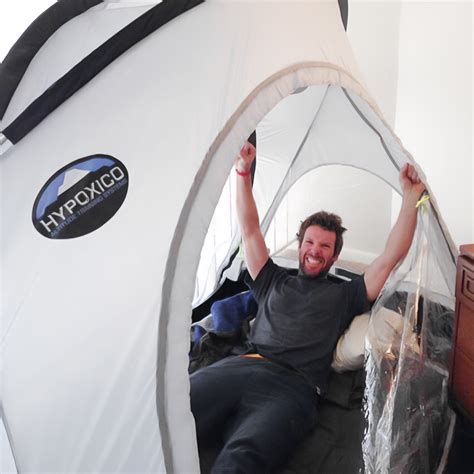
Everest climbers are increasingly turning to hypoxic tents, simulating high-altitude conditions, in their homes to pre-acclimatize and significantly enhance their performance on the world’s highest peak, according to recent findings. This method allows climbers to kickstart the acclimatization process before even setting foot on the mountain, contributing to faster ascents and potentially safer expeditions.
The use of hypoxic tents is emerging as a crucial component in the training regimen of elite mountaineers, mimicking the oxygen-depleted environment found at extreme altitudes. By sleeping, training, and resting in these specialized tents, climbers force their bodies to adapt to lower oxygen levels, triggering physiological changes that boost red blood cell production, improve oxygen delivery to muscles, and increase overall endurance.
“Pre-acclimatization offers a significant advantage,” says Dr. Kenneth Baillie, a critical care doctor and genetics researcher at the University of Edinburgh, as reported in the original article. This advantage translates to reduced risk of altitude sickness, faster acclimatization once on the mountain, and the potential for quicker, more efficient climbs.
The trend is not just limited to professional climbers; amateur mountaineers and even athletes in other endurance sports are exploring the benefits of hypoxic training. As technology improves and the tents become more accessible, the practice is becoming increasingly mainstream, raising questions about its long-term effects and ethical implications.
The Science Behind Hypoxic Tents
Hypoxic tents, also known as altitude tents, work by reducing the percentage of oxygen in the air within the enclosed space. Normal air contains approximately 20.9% oxygen, while the air inside a hypoxic tent can be adjusted to simulate altitudes ranging from a few thousand feet to the summit of Mount Everest.
When the body is exposed to this oxygen-deprived environment, it responds by initiating a cascade of physiological adaptations aimed at improving oxygen uptake and utilization. The primary adaptation is an increase in the production of erythropoietin (EPO), a hormone that stimulates the bone marrow to produce more red blood cells. Red blood cells contain hemoglobin, the protein responsible for carrying oxygen from the lungs to the body’s tissues.
“The body responds to the simulated altitude by increasing red blood cell production, which allows for more efficient oxygen transport,” explains Dr. Baillie. “This, in turn, can improve performance at high altitudes.”
Other adaptations that occur during hypoxic training include:
- Increased ventilation: The body breathes more deeply and frequently to compensate for the lower oxygen levels.
- Pulmonary vasoconstriction: Blood vessels in the lungs constrict, directing blood flow to areas where oxygen uptake is more efficient.
- Increased mitochondrial density: Mitochondria are the powerhouses of cells, and an increase in their density improves the ability of muscles to use oxygen.
- Changes in enzyme activity: Enzymes involved in energy production adapt to function more efficiently in low-oxygen conditions.
These adaptations collectively enhance the body’s ability to perform at high altitudes, reducing the risk of altitude sickness and improving overall endurance.
Benefits for Everest Climbers
For Everest climbers, the benefits of pre-acclimatization using hypoxic tents are particularly significant. The ascent of Everest is a grueling undertaking that requires weeks of acclimatization to the extreme altitude. Climbers typically spend days or even weeks at base camp and in intermediate camps, gradually ascending and descending to allow their bodies to adapt to the thinning air.
“Hypoxic tents can shorten the acclimatization process on the mountain,” says veteran mountaineer and guide, David Jones. “By arriving at base camp already partially acclimatized, climbers can reduce the time spent at high altitudes, minimizing their exposure to the risks associated with prolonged exposure to low oxygen levels.”
These risks include:
- Acute Mountain Sickness (AMS): A common condition that can cause headache, nausea, fatigue, and dizziness.
- High Altitude Pulmonary Edema (HAPE): A life-threatening condition in which fluid accumulates in the lungs.
- High Altitude Cerebral Edema (HACE): A life-threatening condition in which fluid accumulates in the brain.
By reducing the time spent at high altitudes, pre-acclimatization can significantly lower the risk of these conditions. Furthermore, it can improve climbers’ overall performance, allowing them to ascend more quickly and efficiently.
Beyond Everest: Applications in Other Sports
The benefits of hypoxic training are not limited to mountaineering. Athletes in other endurance sports, such as running, cycling, and triathlon, are also exploring the potential of hypoxic tents to enhance their performance.
“Hypoxic training can improve endurance and speed in a variety of sports,” says Dr. Emily Carter, a sports medicine physician specializing in altitude training. “By forcing the body to adapt to low-oxygen conditions, athletes can increase their red blood cell production, improve their oxygen uptake, and enhance their overall performance.”
Studies have shown that hypoxic training can lead to improvements in:
- VO2 max: The maximum amount of oxygen the body can use during exercise.
- Lactate threshold: The point at which lactate begins to accumulate in the blood, indicating that the body is relying more on anaerobic metabolism.
- Time to exhaustion: The length of time an athlete can exercise at a given intensity before becoming exhausted.
While the benefits of hypoxic training for endurance athletes are well-documented, it is important to note that it is not a magic bullet. It should be used in conjunction with other training methods, such as strength training and interval training, to achieve optimal results.
Ethical Considerations
The increasing use of hypoxic tents raises ethical questions, particularly in the context of competitive sports. Some argue that it gives athletes an unfair advantage over those who do not have access to the technology.
“There is a concern that hypoxic training could be considered a form of artificial performance enhancement,” says Professor Mark Johnson, a bioethicist specializing in sports ethics. “It is important to consider whether it violates the spirit of fair play.”
However, others argue that hypoxic training is simply a tool that athletes can use to improve their performance, similar to other training methods, such as weightlifting or interval training.
“Hypoxic training is not inherently unethical,” says Dr. Carter. “It is a legitimate training method that can help athletes improve their performance. The key is to ensure that it is used responsibly and ethically.”
The World Anti-Doping Agency (WADA) has not banned the use of hypoxic tents, but it continues to monitor the technology and its potential impact on fair play.
The Future of Hypoxic Training
As technology improves and hypoxic tents become more accessible, the practice is likely to become even more widespread. Researchers are continuing to explore the potential benefits and risks of hypoxic training, and new applications are constantly being discovered.
“We are only beginning to understand the full potential of hypoxic training,” says Dr. Baillie. “As we learn more about the physiological mechanisms involved, we can develop more effective and targeted training protocols.”
One area of ongoing research is the use of intermittent hypoxic training (IHT), which involves alternating between periods of hypoxia and normoxia (normal oxygen levels). IHT has been shown to be effective in improving performance in a variety of sports, and it may also have therapeutic applications for conditions such as asthma and chronic obstructive pulmonary disease (COPD).
Another area of research is the use of hypoxic tents for pre-acclimatization to high altitude. As more climbers and trekkers venture into high-altitude environments, the need for effective acclimatization strategies is growing. Hypoxic tents offer a convenient and effective way to pre-acclimatize to high altitude, reducing the risk of altitude sickness and improving overall performance.
Practical Considerations for Using Hypoxic Tents
Before using a hypoxic tent, it is important to consult with a physician or qualified healthcare professional to ensure that it is safe and appropriate for you. Hypoxic training is not suitable for everyone, and it can pose risks for individuals with certain medical conditions, such as heart disease or lung disease.
If you are cleared to use a hypoxic tent, it is important to follow the manufacturer’s instructions carefully. Start with low altitude simulations and gradually increase the altitude over time. Monitor your symptoms closely and discontinue use if you experience any adverse effects, such as headache, nausea, or dizziness.
It is also important to ensure that the hypoxic tent is properly ventilated to prevent the buildup of carbon dioxide. Carbon dioxide can accumulate in enclosed spaces, leading to hypercapnia, a condition in which there is too much carbon dioxide in the blood.
Finally, it is important to be aware of the potential psychological effects of hypoxic training. Spending long periods of time in a confined space with reduced oxygen levels can be stressful and anxiety-provoking for some individuals.
The Cost of Hypoxic Tents
The cost of hypoxic tents can vary widely, depending on the size, features, and quality of the tent. Basic models can cost a few thousand dollars, while more sophisticated models can cost tens of thousands of dollars.
The cost of hypoxic training also includes the cost of electricity to power the tent and the cost of maintenance and repairs.
While hypoxic tents can be expensive, they can be a worthwhile investment for individuals who are serious about improving their performance at high altitude or in endurance sports.
Conclusion
Hypoxic tents are becoming increasingly popular among Everest climbers, endurance athletes, and individuals seeking to improve their health and well-being. By simulating high-altitude conditions, these tents can trigger a cascade of physiological adaptations that enhance oxygen uptake and utilization, improve endurance, and reduce the risk of altitude sickness.
While the benefits of hypoxic training are well-documented, it is important to use it responsibly and ethically. Consult with a physician or qualified healthcare professional before using a hypoxic tent, and follow the manufacturer’s instructions carefully.
As technology improves and hypoxic tents become more accessible, the practice is likely to become even more widespread. Researchers are continuing to explore the potential benefits and risks of hypoxic training, and new applications are constantly being discovered.
Frequently Asked Questions (FAQ)
-
What exactly is a hypoxic tent and how does it work? A hypoxic tent, also known as an altitude tent, is an enclosed space designed to simulate high-altitude conditions by reducing the oxygen concentration in the air. Normal air contains approximately 20.9% oxygen, while a hypoxic tent can be adjusted to reduce this percentage, mimicking altitudes ranging from a few thousand feet to the summit of Mount Everest. This oxygen deprivation forces the body to adapt, primarily by increasing red blood cell production to improve oxygen carrying capacity. The technology works by using a generator that filters out a portion of the oxygen from the air, delivering air with a lower oxygen concentration into the enclosed tent. This allows individuals to sleep, rest, or even exercise in an environment that mimics the physiological stresses of high altitude.
-
What are the main benefits of using a hypoxic tent for Everest climbers? For Everest climbers, the primary benefits of using a hypoxic tent involve pre-acclimatization to the extreme altitude. By sleeping and resting in a hypoxic tent before arriving at base camp, climbers can:
- Reduce the Risk of Altitude Sickness: Pre-acclimatization decreases the likelihood and severity of conditions like Acute Mountain Sickness (AMS), High Altitude Pulmonary Edema (HAPE), and High Altitude Cerebral Edema (HACE).
- Shorten On-Mountain Acclimatization Time: Climbers can reduce the time spent acclimatizing at base camp and intermediate camps, minimizing their exposure to the dangers of high altitude.
- Improve Performance: Pre-acclimatization enhances overall endurance, allowing for quicker and more efficient ascents.
- Increase Red Blood Cell Production: Simulating high altitude triggers the body to produce more red blood cells, which improves oxygen transport throughout the body. These benefits collectively contribute to safer and more successful Everest expeditions.
-
Are there any risks or side effects associated with using hypoxic tents? Yes, there are potential risks and side effects associated with using hypoxic tents. It’s crucial to consult with a healthcare professional before starting hypoxic training. Potential risks include:
- Hypoxia-Related Symptoms: Headaches, nausea, dizziness, and fatigue can occur, especially when starting at higher simulated altitudes or increasing the altitude too quickly.
- Respiratory Issues: The body’s increased ventilation (breathing rate) can sometimes lead to discomfort or hyperventilation.
- Cardiovascular Stress: Individuals with pre-existing heart conditions may experience increased stress on their cardiovascular system.
- Psychological Effects: Prolonged exposure to low-oxygen environments can induce stress, anxiety, or claustrophobia.
- Carbon Dioxide Buildup: In poorly ventilated tents, carbon dioxide can accumulate, leading to hypercapnia (excess carbon dioxide in the blood). It’s essential to monitor symptoms closely, maintain proper ventilation, and gradually increase the simulated altitude to minimize these risks.
-
Can athletes in other sports besides mountaineering benefit from using hypoxic tents? Absolutely. Athletes in various endurance sports, such as running, cycling, swimming, and triathlon, can benefit from hypoxic training. The key benefits include:
- Improved VO2 Max: Hypoxic training can increase the maximum amount of oxygen the body can utilize during exercise.
- Increased Lactate Threshold: It can raise the point at which lactate starts accumulating in the blood, allowing athletes to sustain higher intensities for longer.
- Enhanced Endurance: Hypoxic training improves overall endurance and reduces time to exhaustion.
- Increased Red Blood Cell Production: Similar to mountaineering, endurance athletes can enhance their oxygen transport capacity. By improving these physiological parameters, hypoxic training can lead to enhanced performance in endurance-based activities.
-
What are the ethical considerations surrounding the use of hypoxic tents in sports? The use of hypoxic tents in sports raises several ethical concerns, primarily related to fair play and access. The main considerations include:
- Unfair Advantage: Some argue that hypoxic tents provide an unfair advantage to athletes who have access to this technology, potentially disadvantaging those who do not.
- Artificial Performance Enhancement: There is debate over whether hypoxic training should be considered a form of artificial performance enhancement, potentially violating the spirit of fair competition.
- Accessibility and Equity: The cost and availability of hypoxic tents raise questions about equity, as not all athletes have the financial resources to access this technology.
- Regulation and Monitoring: There is ongoing discussion about the need for regulations and monitoring to ensure that the use of hypoxic tents does not compromise the integrity of sports. While the World Anti-Doping Agency (WADA) has not banned hypoxic tents, they continue to monitor the technology and its potential impact on fair play. It’s important for sports organizations to establish clear guidelines to ensure that the use of hypoxic training aligns with principles of fairness and equity.
Expanded Context and In-Depth Analysis
The utilization of hypoxic tents represents a significant advancement in the preparation and training methodologies employed by mountaineers and endurance athletes. This technology’s impact extends beyond mere physical conditioning, influencing strategic planning, safety protocols, and even the psychological readiness of individuals undertaking challenging feats.
Historical Perspective: The Evolution of Altitude Training
Altitude training, the practice of exposing individuals to reduced oxygen levels to enhance their physiological capacity, is not a new concept. Its origins can be traced back to the mid-20th century when athletes and researchers began to recognize the performance-enhancing effects of living and training at high altitudes. The 1968 Summer Olympics in Mexico City, held at an altitude of 7,350 feet (2,240 meters), brought the concept of altitude acclimatization into the mainstream. Athletes from countries with high-altitude environments, such as Kenya and Ethiopia, demonstrated remarkable endurance performance, prompting further investigation into the benefits of altitude exposure.
Initially, altitude training involved relocating to high-altitude locations for extended periods. This approach, however, presented logistical challenges, including the cost of travel and accommodation, disruption of training schedules, and potential health risks associated with prolonged exposure to high altitude. The development of hypoxic tents offered a more convenient and controlled alternative, allowing athletes and mountaineers to simulate high-altitude conditions in their homes or training facilities.
The Physiological Adaptations in Detail
The primary physiological adaptation induced by hypoxic training is an increase in red blood cell production, a process known as erythropoiesis. This process is stimulated by the release of erythropoietin (EPO) from the kidneys in response to low oxygen levels. EPO travels to the bone marrow, where it stimulates the production of red blood cells. The increased red blood cell mass enhances the oxygen-carrying capacity of the blood, allowing for more efficient oxygen delivery to the muscles and other tissues.
In addition to increased red blood cell production, hypoxic training triggers a cascade of other physiological adaptations, including:
- Increased Ventilation: The body increases its breathing rate and depth to compensate for the lower oxygen levels. This increased ventilation helps to maintain adequate oxygen saturation in the blood.
- Pulmonary Vasoconstriction: The blood vessels in the lungs constrict in response to low oxygen levels. This constriction redirects blood flow to areas of the lungs where oxygen uptake is more efficient.
- Increased Capillary Density: The number of capillaries (small blood vessels) in the muscles increases. This increased capillary density enhances oxygen delivery to the muscle cells.
- Increased Mitochondrial Density: The mitochondria, which are the powerhouses of cells, increase in number and size. This increased mitochondrial density enhances the ability of the muscle cells to use oxygen.
- Changes in Enzyme Activity: The activity of enzymes involved in energy production changes to function more efficiently in low-oxygen conditions.
These adaptations collectively enhance the body’s ability to perform in low-oxygen environments, improving endurance, reducing fatigue, and increasing overall performance.
Strategic Implications for Everest Expeditions
The use of hypoxic tents has profound strategic implications for Everest expeditions. Traditionally, climbers spend weeks at base camp and intermediate camps, gradually ascending and descending to allow their bodies to acclimatize to the thinning air. This process is time-consuming, exposes climbers to the risks of altitude sickness, and can be psychologically taxing.
Pre-acclimatization with hypoxic tents can significantly reduce the time required for on-mountain acclimatization. Climbers who arrive at base camp already partially acclimatized can proceed more quickly through the acclimatization process, minimizing their exposure to the risks of high altitude and increasing their chances of a successful summit.
Furthermore, pre-acclimatization can improve climbers’ decision-making abilities at high altitude. Altitude sickness can impair cognitive function, making it difficult for climbers to make sound judgments. By reducing the risk of altitude sickness, pre-acclimatization can help climbers maintain their cognitive abilities and make better decisions in challenging situations.
Safety Protocols and Emergency Preparedness
The use of hypoxic tents also has implications for safety protocols and emergency preparedness on Everest. Climbers who are better acclimatized are less likely to develop altitude sickness, reducing the need for emergency medical interventions. In the event that a climber does develop altitude sickness, pre-acclimatization can improve their chances of a successful recovery.
Mountaineering teams are increasingly incorporating hypoxic tents into their overall safety strategy. Before an expedition, team members undergo pre-acclimatization using hypoxic tents, allowing them to arrive at base camp with a higher level of physiological preparedness. This, in turn, reduces the overall risk of altitude-related illnesses and improves the team’s ability to respond effectively to emergencies.
Psychological Readiness and Confidence
The psychological benefits of pre-acclimatization should not be underestimated. Knowing that they have already adapted to some degree to the low-oxygen environment can boost climbers’ confidence and reduce anxiety. This increased confidence can translate into better performance and a more positive overall experience.
Mountaineering is a highly demanding activity that requires not only physical strength and endurance but also mental fortitude. Climbers who are psychologically prepared for the challenges of high altitude are more likely to persevere in the face of adversity and achieve their goals.
Beyond the Individual: Benefits for Expedition Teams
The advantages of hypoxic tents extend beyond individual climbers to benefit entire expedition teams. With more team members arriving pre-acclimatized, the resources dedicated to managing altitude sickness can be reduced. This allows expedition leaders to focus on other critical aspects of the climb, such as route planning, weather monitoring, and logistical support.
A team with fewer members suffering from altitude sickness is also a more cohesive and effective team. Climbers who are feeling well are better able to support their teammates and contribute to the overall success of the expedition.
Challenges and Limitations
While hypoxic tents offer numerous benefits, they also have limitations and challenges. One of the main challenges is the cost. Hypoxic tents can be expensive to purchase and operate, making them inaccessible to many climbers and athletes.
Another limitation is the inconvenience of using a hypoxic tent. Sleeping in a tent every night can be uncomfortable, and some individuals may find it difficult to adjust to the confined space.
Furthermore, the long-term effects of hypoxic training are not fully understood. More research is needed to determine the potential risks and benefits of prolonged exposure to low-oxygen environments.
The Future of Altitude Simulation Technology
The technology behind hypoxic tents is constantly evolving. Researchers are developing new and improved methods for simulating high-altitude conditions, including:
- Hypoxic Chambers: These are larger, more sophisticated versions of hypoxic tents that can accommodate multiple individuals and allow for more controlled environmental conditions.
- Intermittent Hypoxic Training (IHT): This involves alternating between periods of hypoxia and normoxia (normal oxygen levels). IHT has been shown to be effective in improving performance in a variety of sports.
- Remote Monitoring and Telemedicine: Advances in remote monitoring and telemedicine are allowing healthcare professionals to track climbers’ physiological parameters in real-time and provide remote medical support.
These technological advancements are poised to further enhance the safety and effectiveness of altitude training and acclimatization.
The Role of Personalized Medicine
As our understanding of the human body and its response to altitude improves, personalized medicine is likely to play an increasingly important role in altitude training. By analyzing an individual’s genetic makeup, physiological characteristics, and medical history, healthcare professionals can tailor altitude training protocols to optimize their response and minimize their risk of adverse effects.
Personalized altitude training may involve adjusting the simulated altitude, duration of exposure, and training intensity based on an individual’s unique needs and goals. This approach has the potential to significantly improve the effectiveness of altitude training and make it more accessible to a wider range of individuals.
Conclusion: A Paradigm Shift in Mountaineering and Sports Science
The use of hypoxic tents represents a paradigm shift in the way mountaineers and athletes prepare for challenging environments. This technology has revolutionized altitude training, offering a convenient, controlled, and effective method for pre-acclimatizing to high altitude and improving performance in endurance sports.
While challenges and limitations remain, the benefits of hypoxic tents are undeniable. As technology continues to evolve and our understanding of the human body deepens, hypoxic training is likely to become even more widespread and sophisticated, further enhancing the safety, performance, and overall experience of individuals venturing into high-altitude environments or pushing their limits in endurance sports. The integration of hypoxic tents into training regimes reflects a broader trend towards leveraging scientific advancements to optimize human performance and mitigate the risks associated with extreme environments.









